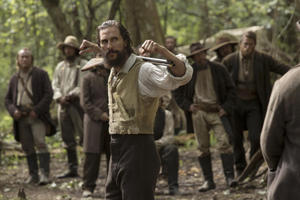
THE SHALLOWS
Unless you’re in the ocean and one is heading directly toward you, dorsal fins, thanks to Jaws, are inherently funny/scary. So is director Jaume Collet-Serra’s The Shallows, in which Blake Lively finds herself tormented by a shark for close to an hour and a half. I’ll offer further plot synopsis, but that’s pretty much it. It’s Blake Lively, and a shark, and about 90 minutes – and happily, the star, the fish, and the film’s length are all just what you want and need them to be.
In truth, Collet-Serra’s aquatic thriller could have stood to be even a tad shorter. There’s some opening exposition as Lively’s vacationing Nancy is driven to a remote Mexican beach, and a bit more as she FaceTime-chats with her father and sister, and we do learn some essential narrative details: that Nancy, despite top grades, recently dropped out of medical school; that her mother recently fought a losing battle against cancer. But while these delays of the inevitable are kind of necessary, you can’t really say the same of the early, time-killing scenes of Nancy and a pair of fellow surfers hanging 10 on their boards, or the many slow-motion shots of the bikini-clad Lively navigating the waves or simply combing the beach. (Whenever the camera lingers on Lively’s tanned and toned physique, The Shallows tends to resemble a severely under-cast episode of Baywatch.) In due time, though, Nancy surfs out toward a strange-looking protrusion in the water, and realizes, to her shock, that’s it’s a floating, gored, dead whale. Then the shark shows up, with Nancy forced to take refuge on that whale’s carcass. And then the movie really gets rolling.

“Shows up” is probably the wrong phrase for the shark’s debut, because it more accurately explodes, catapulting through a wave that Nancy is traversing in what’s likely a crime against physics (although not against the rules of fright flicks). But while the fish’s movements, especially toward the end, occasionally defy belief, Collet-Serra, screenwriter Anthony Jaswinski, and Lively manage to keep the threat intensely human-scaled. Like 127 Hours and All Is Lost, the film emerges as a one-person procedural on single-handedly surviving an impossible situation, and The Shallows’ star radiates such intelligence and problem-solving skills that the movie proves just as exciting as it would’ve been had the Mexican lagoon been loaded with chum. (Even though it’s not, those hungry for human shark-bait won’t leave disappointed, and I was amazed that with a cast numbering fewer than 10, Collet-Serra and Jaswinski were still able to include a character we were dying to see get eaten alive.) Nancy’s med-school training certainly comes in handy, particularly when she’s forced to close the gash on her thigh using only her earrings. But armed with nothing more than smarts, good sense, and a functional watch, she’s also a fiercely combative survivor, and Nancy’s do-or-die scenario – trying to get from the whale to a reef, and from the reef to a buoy – proves harrowing in a supremely enjoyable way. With cinematographer Flavio Martínez Labiano keeping his camera incredibly close to his subject’s face and body, we feel the physical toll on our heroine, and Lively’s openness and natural empathy ensure that we feel the emotional one, as well. Collet-Serra, however, is an entertainer first and foremost (his credits include the Liam Neeson action pics Unknown and Non-Stop), and while the shark’s threat is punishing for Nancy, it never is for us.
We’re treated to marvelously staged, stomach-tightening sequences of Nancy attempting to make contact with the few beach visitors she sees, either to get them to aid her, or – with that dorsal fin making frequent appearances – to keep them away. Collet-Serra provides some ticklish visual distraction involving Nancy’s watch and the ticking down of 30-second increments, plus a nightmarish image of the shark deciding that a buoy would make for a perfect early-evening snack. There’s coral that stings like jellyfish and jellyfish that sting like hell, and Lively gets her own juicy take on Jaws’ “Smile, you son of a bitch!” line that still doesn’t lead to the shark’s demise. And because there’s also some Cast Away in the DNA for this terrifically engaging, nerve-racking film, The Shallows even delivers its own version of Tom Hanks’ volleyball in the form of a friendly, wounded seagull – one that actually squawks for Nancy’s attention when it sees help approaching. You’d never get such anthropomorphic assistance from Wilson, that smiling son of a bitch.

FREE STATE OF JONES
When it comes to appraisals of the arts, the adjective “solid” can seem like a pejorative – an equivalent to “decent” or “fine” that sounds as much like an insult as it does a compliment. But when I say that writer/director Gary Ross’ Free State of Jones is a solid Civil War movie, I mean it as nearly undiluted praise; it’s nothing more or less than a strong story well-told, and for this particular subject, that proves to be more than enough. Telling of a rogue band of Confederates who successfully rallied against the rich white Southerners and military men who were disenfranchising slaves and white farmers alike (although by no means exactly alike), Ross examines a little-known and very specific piece of history here, and the film clearly benefits from its specificity. Unencumbered by any need to make this Civil War drama an epic, Ross is free to stage intense, grisly battle scenes without grandiosity or excess. (His brutal, brilliantly edited combat opener suggests just how terrifying Ross’ original Hunger Games movie might have been if not constrained by its PG-13 rating.) And because the story’s arc is viewed in low-key, humanist terms, the scenes of political contemplation and strategic maneuvering don’t feel like the typically humdrum placeholders you sit through before getting to the next high point; the quiet scenes are the high points. Free State of Jones is a delicate yet forceful exploration of worth, and self-worth, punctuated by random moments of shocking violence, and it boasts numerous haunting grace notes: the repeated visual motif of Confederate deserters walking the shallow waters of a swamp, first in pairs, and then in dozens; a trio of farm women carrying stools across an open field to cut their lynched kinfolk down from trees.
If Ross’ achievement is more solid than exceptional, that’s because it’s a very traditional movie – we’re given one main Confederate baddie to hiss and one Confederate underling to hiss just a little bit less – and it features only perfunctory dialogue and a really unnecessary subplot in which we routinely flash-forward 85 years to a courtroom in the Jim Crow-era South. (You can see what parallels Ross is making with this narrative device, but losing these segments wouldn’t have hurt the 140-minute film at all, and would certainly have aided its momentum.) Yet it’s all gorgeously photographed by Benoît Delhomme, and amidst an excellent cast that includes Gugu Mbatha-Raw, Mahershala Ali, Keri Russell, and the heartbreaking Jacob Lofland, lead Matthew McConaughey earns best-in-show honors, partly for the pleasure in watching him not devour the scenery. As the rebel leader Newton Knight, McConaughey gives a typically vigorous but atypically restrained portrayal of a heroic crusader who also has a touch of Jim Jones about him, and even his one sobbing meltdown is handled (with Ross’ aid) with disarming tact. It’s lovely, thoughtful, nuanced work, and consequently a perfect match for Free State of Jones itself.

THE NEON DEMON
According to reports, director Nicolas Winding Refn’s The Neon Demon was booed, vociferously, at the Cannes Film Festival last month. (One particular Vulture article stated that when the film ended with a dedication to Refn’s wife Liv, an especially aggrieved patron shouted, “F--- you, Liv!”) Yet for the entire first hour of my Saturday screening, I couldn’t fathom why. Sure, Refn’s tale of a 16-year-old sweetheart (Elle Fanning’s Jesse) who achieves staggering immediate success – and the ire of many – in the Los Angeles modeling industry boasted stilted dialogue and the sorts of pauses between lines that you could drive trucking convoys through. And sure, Refn and cinematographer Natasha Braier were obviously borrowing heavily from ideas in the Lynch and Kubrick catalogs (early on, a model applies lipstick whose color is “Red Rum”), and the pacing was what could be generously described as “deliberate,” and there were unexplainable images galore ... or images that you wound up wishing were unexplainable. (Not long after she starts exhibiting some fierceness and control, Jesse opens the door to her motel room and finds a mountain lion there – an animal that Keanu Reeves’ creepy manager chooses to call “a wildcat.”) But the colors and lighting and compositions were frequently extraordinary, as was composer Cliff Martinez’s score that sounded like a blend of Drive synth and fancy ringtones. The role of Jesse was a strong showcase for Fanning’s nascent acting talents and fragile flower-child beauty, and I got a kick out of seeing Jena Malone, who’s become the most cheerfully perverse young actor in movies, and Christina Hendricks, who looks, as usual, like a zillion bucks. Hell, Karl Glusman – the extremely brave yet extremely blank lead in Gaspar Noé’s sexually explicit Love – was even allowed to be goofy and adorable, Mad Max: Fury Road’s Abbey Lee suggests she’s a star in the making, and all told the whole of The Neon Demon exuded a creepy, suggestive Mulholland Dr. vibe that was totally working for me. What, I thought, was with the booing?
I started to get my answer with the sequence, roughly halfway through the film, of Fanning staring at a neon triangle, and then at reflections of herself kissing herself, for what felt like 10 minutes. I got it a bit more with the dream sequence (or was it?) that found Jesse deep-throating Keanu Reeves’ knife. And a bit more with the audible sexual assault of a 13-year-old girl. And a bit more with the attempted, rebuked lesbian seduction. And a lot more with the lesbian necrophilia. And just when the movie seemed to completely crawl up its own ass with a drained swimming pool and low-budget-horror-flick chase and porn-y shower sequence that’s actually an insult to the term “gratuitous,” Refn and co-screenwriters Mary Laws and Polly Stenham pull out their coup de grâce, revealing that this cinematic allegory for the modeling industry eating its own wasn’t allegorical at all. The Neon Demon is fascinating. It’s almost never boring. It’s probably unforgettable. And I totally get the booing.










